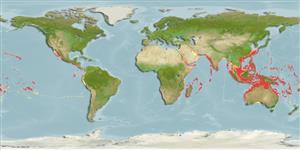Preferred temperature (Ref.
123201): 19.2 - 28.2, mean 26.1 °C (based on 991 cells).
Phylogenetic diversity index (Ref.
82804): PD
50 = 0.5005 [Uniqueness, from 0.5 = low to 2.0 = high].
Bayesian length-weight: a=0.00089 (0.00039 - 0.00204), b=3.00 (2.80 - 3.20), in cm total length, based on LWR estimates for this (Sub)family-body shape (Ref.
93245).
Nivel trófico (Ref.
69278): 3.6 ±0.4 se; based on size and trophs of closest relatives
Resiliencia (Ref.
120179): Medio, población duplicada en un tiempo mínimo de 1.4-4.4 años (Preliminary K or Fecundity.).
Fishing Vulnerability (Ref.
59153): High vulnerability (60 of 100).
Nutrients (Ref.
124155): Calcium = 29.1 [15.6, 50.6] mg/100g; Iron = 0.466 [0.280, 0.952] mg/100g; Protein = 18.7 [16.4, 21.2] %; Omega3 = 0.121 [0.054, 0.337] g/100g; Selenium = 67.5 [38.0, 129.7] μg/100g; VitaminA = 42.2 [13.0, 130.0] μg/100g; Zinc = 0.849 [0.605, 1.190] mg/100g (wet weight);
